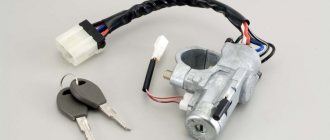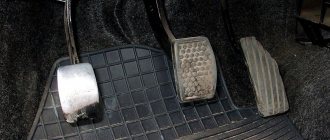Winter is a magical time of year, but with it comes many problems, including for car owners.
One of the common problems that car enthusiasts face during the cold season is freezing of the car door lock cylinder, which occurs even due to trivial things. So, what to do if you are faced with such an opportunity?
Reasons for car door cylinders freezing
There are not so many reasons for freezing, but sometimes we, without even thinking, take steps towards such a problem. Common reasons:
- condensation that forms due to the temperature difference in the air and inside the car;
- a sharp decrease in air temperature after rain or wet snow;
- poor-quality drying of vehicles after a car wash;
- snow getting on the seals, which first melts under the influence of heat from the car’s interior, and then freezes;
- temperature changes from positive to negative temperatures and vice versa.
What not to do if the lock is frozen?
If, nevertheless, you were unable to avoid the problem of the lock freezing, the main thing in this matter is not to do anything stupid and not to aggravate the already stalemate. Let's look at the key mistakes when trying to unlock a frozen car door lock.
- Under no circumstances should you “warm up” the locking mechanism with boiling water. So, you can damage the coating of your car, and when it cools down, there is a high probability that your lock will freeze again.
- If the key is not inserted into the lock or enters but with some effort, and turns “tightly” or does not do so at all, there is no need to try to force insert and open your lock. With a high percentage of probability, the key will simply break, which will add a lot more trouble to you.
- You should not try to warm up the well by breathing. This method will only increase the amount of moisture in it, so it will freeze even more.
- You should not use the “heating the key with fire” method. While you are trying to insert it into the key, it will cool down, and while you are inserting the key, you are more likely to get frostbite yourself.
Note! The described list of what you should not do if the door lock on your car is frozen is made up of the most common mistakes when trying to unlock a frozen car lock. Often, car owners primarily resort to these methods, which further aggravates an already bad situation.
Advice from experienced people
It is impossible not to note the methods used by ordinary car enthusiasts.
These include:
- Using a cigarette lighter. Everything is simple here. Take a heated cigarette lighter from another car, bring it to the frozen lock and hold it until it warms up completely. This technique is simple and effective. There are no risks to the paintwork;
- Using antifreeze. Often, car enthusiasts use conventional coolant with a low freezing point. Such liquids contain ethyl alcohol, which copes well with the problem;
- Vodka to the rescue. If you don’t have anything suggested above at hand, then you can run to the nearest store and buy vodka. By forcing the liquid into the lock with a syringe, you can even deal with “hard-core” ice. At the same time, do not forget to dry the lock as soon as possible, because in addition to alcohol, vodka also contains water;
- Brake fluid. Remember that using a brake guard will help deal with ice, but can cause irreparable damage to the car’s paintwork. So resort to this method only as a last resort;
- Scraper. If you have a quality scraper on hand, you can try to break up the ice with it. The main thing is that the product reaches hard-to-reach places;
- Petrolatum. If there is a pharmacy nearby, you can buy Vaseline and try to deal with the ice with its help. The principle here is simple. Treat the key with Vaseline, insert it into the lock and let it stand for some time (2-3 minutes). Then try turning the key in the lock. You can make several attempts (the break between each of them should be 4-5 minutes).
POPULAR WITH READERS: Details about zero resistance filters
Prevention
In order to be sure in winter that something similar will not happen to you, it is recommended to carry out preventive measures even before the onset of cold weather. What do primitive preventative measures for freezing car locks include?
- First of all, pay attention to the seals. Carefully inspect them for dirt, debris and cracks, since often this oversight can lead to depressurization and allow moisture to get inside, which, in turn, can easily cause not only the locks, but also the doors of your car to freeze.
- Protect the seals with lubricant. All-purpose silicone grease works well. It has a good water-repellent effect and will also extend the life of your seals.
- An effective option is a warm garage or parking lot. So, you will save yourself not only from frozen locks, but also from many problems that plague car enthusiasts during the cold season.
How to open a frozen lock
This section contains more “painless” ways to solve the problem with a frozen car door lock, unlike many others. This does not mean that they will definitely fix the problem; they also need to be careful and careful.
- Using bags of warm sand or heating pads with warm (hot) water. Apply one of the two to the lock, periodically checking for temperature. It is worth assuming that the presented method is quite painstaking, and with its help it will not be possible to quickly open the lock.
- Using a lock defroster (also known as a liquid key). The defroster keychain consists of a simple mechanism and often runs on regular AA batteries. It is equipped with a retractable pin, shaped like a key, which is inserted directly into the keyhole. When pulled out, it begins to heat up automatically, which leads to almost instantaneous thawing of the ice.
- Alcohol or alcohol-containing substances (medicinal alcohol, cologne, eau de toilette, etc.). Since alcohol has the property of generating heat, it can be used to dissolve ice quite quickly.
- A bent hairpin or something similar. Carefully insert one end into the keyhole, heat the other end with a lighter, but do not forget to protect your car, as this method can easily damage the paintwork. Protect the area around the lock with regular cling film.
- If you are in a hurry and the lock does not open, use a kerosene-based liquid used to unscrew the nuts (for example, WD-40). But do not forget that this substance is hygroscopic, and will quite aggravate your situation the next time you open the door.
Attention! After you have opened the keyhole, it is recommended to treat it with a moisture-displacing lubricant so as not to aggravate the problem the next time you try to open the door.
With any of the listed methods of warming up a car lock, you should not rush, but do everything carefully, because with the slightest carelessness you can end up in another situation, the most common of which is the breakage of the key, damage to the internal mechanism of the cylinder. To avoid such unpleasant situations, it is recommended to prepare your car for winter in advance.
Rescue methods
When it’s warm outside, moisture getting into the lock does not pose any risks. Another thing is winter and cold.
Under the influence of low temperatures, the liquid sets, and the lock becomes a useless device.
Opening a car using a key fob or key becomes a difficult task. The situation can be aggravated by battery discharge.
The main thing is to act without panic and not try to open the doors with the help of a “hammer and some kind of mother.”
Today there are many methods to deal with the problem without harming the car.
Let's look at the main ones.
1. Liquid key.
A universal lubricant that allows you to “squeeze” water out of the lock at any outdoor temperature.
The operating range of the product is from -50 to +220 degrees Celsius.
This product not only “dries out” the lock, but also separates the hardware, lubricates and cleans the mechanism, and protects the metal from rust and subsequent freezing.
Algorithm of actions:
- treat each of the locks with the composition;
- wait 5-10 minutes;
- try opening the lock.
If the above manipulations turned out to be useless, try the options below.
As an example, VERYLUBE lock lubricant from XADO is perfect.
2. Open flame.
This method is one of the most popular, but there is little good in it:
- firstly, there is a risk of burning your hands, because warming up a vertical surface is not so easy;
- secondly, you can damage the paint surface of the body itself.
The operating principle is as follows:
- take matches, a lighter or a piece of rolled up newspaper;
- “get” a fire and try to warm up the castle. If you cannot do the work carefully, then limit yourself to heating the key only;
- insert the key into the lock and wait a while until the core warms up;
- try opening the lock.
When performing work, be careful and try not to pull the key too hard so that it does not break.
3. Alcohol.
If you have cologne, a clean bottle of alcohol or eau de toilette on hand, you can use them.
From chemistry lessons we know that alcohol is capable of dissolving ice crust while releasing heat. Moreover, the higher the percentage of alcohol in the liquid, the better.
The algorithm is as follows:
- fill the syringe with 1-2 “cubes” of alcohol (if it is in the bottle) and pour it into the lock under pressure. In the case of eau de toilette, it is enough to spray the composition inside the lock;
- wait 3-5 minutes;
- try opening the lock.
If the car has recently been parked in the cold and you used pure alcohol to defrost, then everything should work out.
4. Glass washing composition.
An excellent alternative to alcohol. This liquid also contains alcohol (only isopropyl), so the effect will be similar to that described above.
At the same time, remember that anti-freeze is an aggressive composition, so you need to avoid contact with liquid.
5. Hot water bottle.
At first glance, this option may seem stupid, but sometimes it really helps.
We are not talking about a classic heating pad with water, but about a bottle of liquid or a bag of warm sand.
POPULAR WITH READERS: Tire fitting, what to pay attention to when changing shoes
It is enough to apply a heat source to a frozen lock for a few seconds to defrost it. At the same time, do not make the mistakes of beginners - do not pour boiling water into the hole.
Such “innovation” can lead to problems with electrical wiring.
6. Cocktail straw.
Many car enthusiasts recommend taking a cocktail straw, inserting it into the keyhole and trying to warm the ice with warm air.
This method has two sides:
- success can only be achieved if the castle has just begun to freeze;
- When it is very cold, it is useless to breathe. In addition, you additionally supply moisture to the lock and, as a result, aggravate the situation. Such heating can lead to even greater freezing.
7. Special anti-rust products.
Every car enthusiast should have WD-40 or another similar product in the trunk.
This substance repels moisture and can help open frozen locks. BUT!
Over time, this composition will absorb moisture, which will lead to the lock freezing in the future and create problems during subsequent attempts to open it.
If there is nothing else at hand, then use this option (you don’t have to choose).
8. Exhaust gases.
This heating method is often used by experienced car enthusiasts. Required items:
- a hose at least 2-3 meters long;
- assistant with work car.
The heating principle is simple.
One end of the hose is put on the exhaust pipe of a running car, and the other is brought to the frozen core of the lock.
As with mouth warming, this can help with minor freezing (but in most cases it can make the problem worse).
9. Silicone grease.
When the lock freezes, you can use any water-repellent composition (including silicone grease). But this method is not always effective.
It will only help if the cause of the “jamming” is a frozen rubber band on the door.
There are times when water gets on the seal, which freezes and prevents the door from opening.
If the problem arose due to moisture getting into the lock itself, then this method will not be effective.
10. Household hair dryer.
If the locks froze while the car was parked next to the house, then you can ask your neighbors to turn on the carrier and warm the locks yourself with a regular hairdryer.
This method is the most loyal and effective. After just 2-3 minutes of the “attack,” the cores will definitely defrost and allow the doors to open.
11. Check if the lock in the trunk is frozen.
On some models, you can open the trunk lid and enter the cabin through the rear seat.
All that remains is to solve the problem with the discharged battery and you can drive the car to a warm room.
12. Warm room.
If none of the methods are useful, then all that remains is to find an assistant and ask to tow the car to a warm garage.
After some time, the locks will thaw themselves and you can open them. But keep in mind that there will be no access to the interior, so the only way out is to use a tow truck or a rigid hitch.
Also read how to make an antifreeze with your own hands.
Frequently asked questions and answers
Why can't you heat the castle with boiling water? I don't see any harm. Answer: hot water can damage the coating of your car due to a sharp temperature change, and also, after the boiling water cools down, it will freeze again, but this time more strongly, since you deliberately poured it there yourself. It will also cause corrosion of the locking mechanism during warming, and then you will definitely have to change the locks.
What about the exhaust method? Answer: Exhaust gases are equivalent to breathing, the effect may be there, but the larva will also quickly “seize” again after it.
I tried to clear the lock with a pocketknife, since I didn’t have anything else at hand. The mechanism broke and had to be replaced. How to carry out prevention in winter so that this definitely doesn’t happen again? Answer: Initially, your idea of such “cleaning” was a failure, since you drove the ice even deeper. Drive the car into a warm box for at least a few hours so that it thaws, clear all the snow from all doors and seals, then wipe it dry. Treat keyholes and seals with moisture-displacing silicone or graphite grease. If your car is on the street, purchase a car cover and cover your car with it. Clean the doors periodically with a brush and you will be happy.
I used the defrost - it didn't help. Are there any analogues to this remedy? Answer: You may have received a low-quality or expired cylinder. If you did everything according to the instructions, then there should be no problems. Let us remind you: inject the product directly into the lock cylinder, wait a while, if it does not help, repeat the procedure. Usually the lock opens the first or second time.
Is it possible to use anti-freeze if there is nothing else at hand? Answer: It is possible, but it is not advisable. Since it is alcohol-based, but do not forget that it contains water.
The lock in the car is frozen, what should I do?
A fairly common situation, especially among novice drivers, is when in the morning, when you approach your car, you cannot get into it because the door lock is frozen and will not open. What to do in such cases, we will discuss in this article.
Almost every motorist has encountered the problem of a frozen lock during their driving practice, at least once - many, having suffered thoroughly, try to prevent it from happening a second time. And they take measures. But sometimes the actions taken do not lead to a positive result. In addition, the majority hopes for the well-known Russian “maybe...”. In general, the problem was, is and will remain relevant.
Causes of lock freezing
The reason is simple to the point of banality - water gets into the lock system, then frost, the water turns into ice, and the moving parts of the mechanism freeze tightly. This unpleasant phenomenon often occurs after a winter car wash - in this case, enough water gets into the lock. And the second reason for water getting into the car lock is temperature changes. Winter very often presents us with surprises in the form of a thaw, when all the snow that has fallen over several days (and sometimes weeks) melts in a matter of hours, and there is so much water on the roads that it is not clear whether the car is moving or floating. And at night it’s frosty. And that's it - the lock won't open. In this article we will focus on the prevention of this phenomenon. But let us especially highlight ways to quickly open a frozen lock.
What to do if the lock is frozen and won’t open
First, you can use various means for defrosting - naturally, it should be in your hands, and not in a locked car. The advantage of this method is that you can quickly, without much effort, melt the ice in the lock mechanism. And safe for car paintwork. On the downside, first of all, there is a risk of buying a fake, which naturally will not work, and you will simply waste time - and locks most often freeze precisely when you are in a hurry to get somewhere.
Secondly, as mentioned above, the product should be available at the moment, and not forgotten inside the car (as luck would have it this time). Therefore, we move on to other methods. If the door key fits all the way into the lock slot, then you can try to vigorously but lightly twist it in the lock - within the limits of its free movement. This method can help if just a little bit of water gets inside. Then there is a chance to turn the key all the way. You can additionally try to gently knock on the lock cylinder itself - just be careful - the most important thing in this method is not to apply significant force. If this does not help, then move on to the next step. The third method is to heat the lock. Let’s make a reservation right away: you shouldn’t pour boiling water on the lock - first of all, you can damage the paintwork. And secondly, especially in very cold weather, the water can instantly freeze, and only worsen the situation. It is best to use some kind of plastic container - a bottle, for example, fill it with hot water and lean it against the lock. However, we think this method is good if you have time - you may have to wait a long time for the lock system to warm up enough.
You can use an ordinary household hair dryer - the method is effective, fast, reliable and safe, of course, provided that this same hair dryer has something to connect to. This method is more suitable for owners of private houses. You can also try heating the key with matches or a lighter - a method that has been repeatedly tested and confirmed its effectiveness. Its main advantage is simplicity. Even if you don’t have a lighter or matches at hand, you can always ask a passerby for them. As a rule, the lock opens on the second or third try. As an option, you can try to warm up the lock itself with a lighter - of course, if you don’t mind the paint in the lock area. And lastly, many drivers recommend using brake fluid or antifreeze to defrost locks. Frankly speaking, the effectiveness of this action is questionable; it is perhaps more suitable for preventing freezing, rather than solving the problem.
Prevention against freezing of locks
It is easier to prevent any problem than to deal with its manifestations in severe frost and in situations of acute lack of time. Let's consider a common situation - washing a car in the cold season. So – the car has just been washed. What should be done? The first, and perhaps most effective, is to leave the car in a warm, dry room for some time to dry. The disadvantage of this method of prevention is obvious - not everyone has this warm, dry room. Let's move on. Second, immediately after washing, blow out the locks with compressed air - as a rule, every car wash has a compressor. The probability of a positive result, in this case, according to observations, is fifty percent. So it alone is clearly not enough. VD-40
liquid is very suitable for this - it displaces water and does not itself freeze in normal (and even severe frosts). Some car enthusiasts, as mentioned above, use antifreeze or brake fluid for the same purposes. Fourth, don’t forget about the rubber seals on the doors - they also freeze perfectly after washing. Possible prevention is to wipe them dry and lubricate them with a special silicone grease for rubber products. It will not only prevent the rubber bands from freezing, but will also extend their service life. Let's summarize: all measures to prevent freezing of car locks come down to removing water from the lock mechanism and preventing it from entering the system. And finally, one more piece of advice: Before you start defrosting the lock, check whether all the doors of your car are frozen and will not open. It will be very disappointing, fiddling with the lock, wasting time to find that one of the doors opens freely, and you can very easily get inside your car, start it and warm it up thoroughly.
We hope that this article was useful to you, please like it!
See also:
| Is it really necessary to warm up the engine? |
| What to do if the washer is frozen? |
| Why do car windows fog up? |











